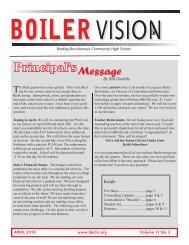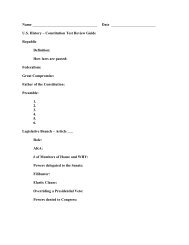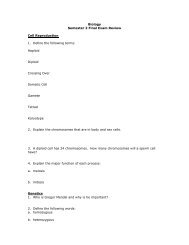Disc Golf Study Guide
Disc Golf Study Guide
Disc Golf Study Guide
Create successful ePaper yourself
Turn your PDF publications into a flip-book with our unique Google optimized e-Paper software.
<strong>Disc</strong> <strong>Golf</strong> <strong>Study</strong> <strong>Guide</strong><br />
History<br />
<strong>Disc</strong> <strong>Golf</strong> is a new sport that was first played in the state of California in the late<br />
1960’s. The game is called disc (disk) golf because the name Frisbee is a<br />
trademarked name and cannot be used. The Professional Disk <strong>Golf</strong> Association<br />
(PDGA) was formed in 1976. The purpose of the PDGA was to promote the<br />
sport, govern rules, and sanction competitive events. The sport of disc golf is<br />
unique because it can be played by people of all ages and is not limited to just<br />
the young.<br />
It is also a relatively inexpensive game to play. Many courses are free to play and<br />
a beginner only needs a disc to play. There are three different classifications for<br />
discs—driver, mid-range driver and putter. Only one disc is needed to play disc<br />
golf. However, many beginners start with two discs- a driver and a putt/approach.<br />
More experienced players are likely to carry six or more discs in their bag to use<br />
on any given course.<br />
Rules of Play<br />
Object—To have fun and play the course from beginning to end in the fewest<br />
throws possible.<br />
Tee Off—Tee shots (drives) must be released from within the designated tee<br />
area<br />
Lie-- The spot where the disc comes to rest.<br />
Throwing order—The player with the lowest score on the previously played hole<br />
tees off first at the next hole and then the second lowest, third lowest, etc. After<br />
the tee shot, the player whose disc is farthest from the hole shoots next. To be<br />
safe and courteous, all players should remain behind the player about to shoot.<br />
Fairway throws—Must be made from where the disc lands (lie). A run-up and<br />
follow through is permitted.<br />
Putt--- A player may not step past the lie when making a throw.<br />
Completion of a hole-The hole is completed when the disc is in the basket or<br />
supported by the chains<br />
Courtesy—Do not throw until the players and all other students are out of range.<br />
Do not attempt to distract players.<br />
Keeping score—Players count the number of throws used to get the disc into<br />
the basket and record the number of throws on the score card by their name.<br />
Once a player has played all 12 holes, he/she should total the scores for each<br />
hole together to come up with their score on the course.<br />
Hole Marker- Located at each hole to provide information about the hole. The<br />
marker tells you the hole number, par for the hole and tee distance(s). If there<br />
are two distances listed on the marker, there are two tee areas at the hole.<br />
Normally, the long tee is the men’s tee area and the shorter tee is the women’s<br />
tee area.
Captains Choice- Team play as opposed to individual play with traditional golf.<br />
In a captain’s choice formatted game of disc golf, each player tees off on each<br />
hole. The best of the tee shots is selected and all players play their second shots<br />
from that spot. The better of the second shots is determined, and then all play<br />
their third shots from that spot, and so on until the disc is in the disc catcher.<br />
Players should be designated Player A, Player B, and Player C, and so on<br />
depending<br />
on the total number of players in a group. Players should then play the each shot<br />
in the order A thru D until the hole is completed.<br />
Match Play -In match play, each hole is a separate competition. The player with<br />
the fewest strokes on an individual hole wins that hole; the player winning the<br />
most holes wins the match.<br />
Stroke Play - The stroke total for 9 (18) holes simply doesn't matter in match<br />
play. Stroke play is more a player vs. the course approach; match play is directly<br />
player vs. player, or side vs. side. There is one opponent you must beat, and that<br />
is the course.<br />
Other Rules:<br />
A player may not step past the lie of the previous throw when attempting her/his<br />
next throw.<br />
No follow-through steps are allowed within 30 feet of the pin.<br />
Terms-<br />
Par- the average number of throws for an experienced player to complete a hole.<br />
The standard score for a hole.<br />
Birdie- one stroke under par<br />
Eagle- two strokes under par<br />
Bogey- one stroke over par<br />
Double bogey- two strokes over par<br />
Drive- a long distance shot towards the hole<br />
Putt/Approach- short distance shot toward the hole<br />
Lie- the spot where the disc lands and the next shot is taken<br />
Mulligan- Free throw that does not cost a stroke<br />
Fore- Protect your head<br />
Pin- Hole or object that is made or hit<br />
Hole in One – Made in one throw<br />
Away- Player farthest from the hole






![New Student Course Guide[2] - Bradley-Bourbonnais Community ...](https://img.yumpu.com/47451319/1/190x245/new-student-course-guide2-bradley-bourbonnais-community-.jpg?quality=85)









